
2021
AP
®
Computer Science A
Sample Student Responses
and Scoring Commentary
Inside:
Free Response Question 3
•• Scoring Guideline
•• Student Samples
•• Scoring Commentary
© 2021 College Board. College Board, Advanced Placement, AP, AP Central, and the acorn logo are registered
trademarks of College Board. Visit College Board on the web: collegeboard.org.
AP Central is the ocial online home for the AP Program: apcentral.collegeboard.org.

AP® Computer Science A 2021 Scoring Guidelines
© 2021 College Board
Applying the Scoring Criteria
Apply the question scoring criteria first, which always takes precedence. Penalty points can only be
deducted in a part of the question that has earned credit via the question rubric. No part of a question (a, b, c)
may have a negative point total. A given penalty can be assessed only once for a question, even if it occurs
multiple times or in multiple parts of that question. A maximum of 3 penalty points may be assessed per
question.
1-Point Penalty
v) Array/collection access confusion ([] get)
w) Extraneous code
t
hat causes side-effect (e.g., printing to
output, incorrect precondition check)
x) Local variables used but none declared
y) Destruction of persistent data (e.g., changing value referenced by parameter)
z) Void method or constructor that returns a value
No Penalty
• Extraneous code
with no side-effect (e.g., valid precondition check, no-op)
• Spelling/case discrepancies where there is no ambiguity*
• Local variable not declared p
rovided other variables are declared in some part
• private or public qualifier on a local variable
• Missing public qualifier on class or constructor header
• Keyword used as an identifier
• Common mathematical symbols used for operators (× • ÷ ≤ ≥ <> ≠)
• [] vs. () vs. <>
• = instead of == and vice
vers
a
• length/size confusion for array, String, List,
or ArrayList
; with or without ( )
• Extraneous [] when referencing entire array
• [i,j] instead of [i][j]
• Ext
rane
ous size in array declaration, e.g., int[size] nums = new int[size];
• Missing ; where structure clearly conveys intent
• Missing { } where indentation clearly conveys intent
• Missing ( ) on parameter-less method o
r constructor invocations
• Missing ( ) aroun
d if or while conditions
*Spe
lling and case discrepancies for ide
ntifiers fall under the “No Penalty” category only if the correction can
be unam biguously inferred from context, for example, “ArayList” instead of “ArrayList”. As a counterexample,
note that if the code declares "
in
t G=99, g=0;", then uses
"while (G < 10)" instead of
"while (g < 10)", the context does not allow for the reader to assume the use of the lower case
variable.
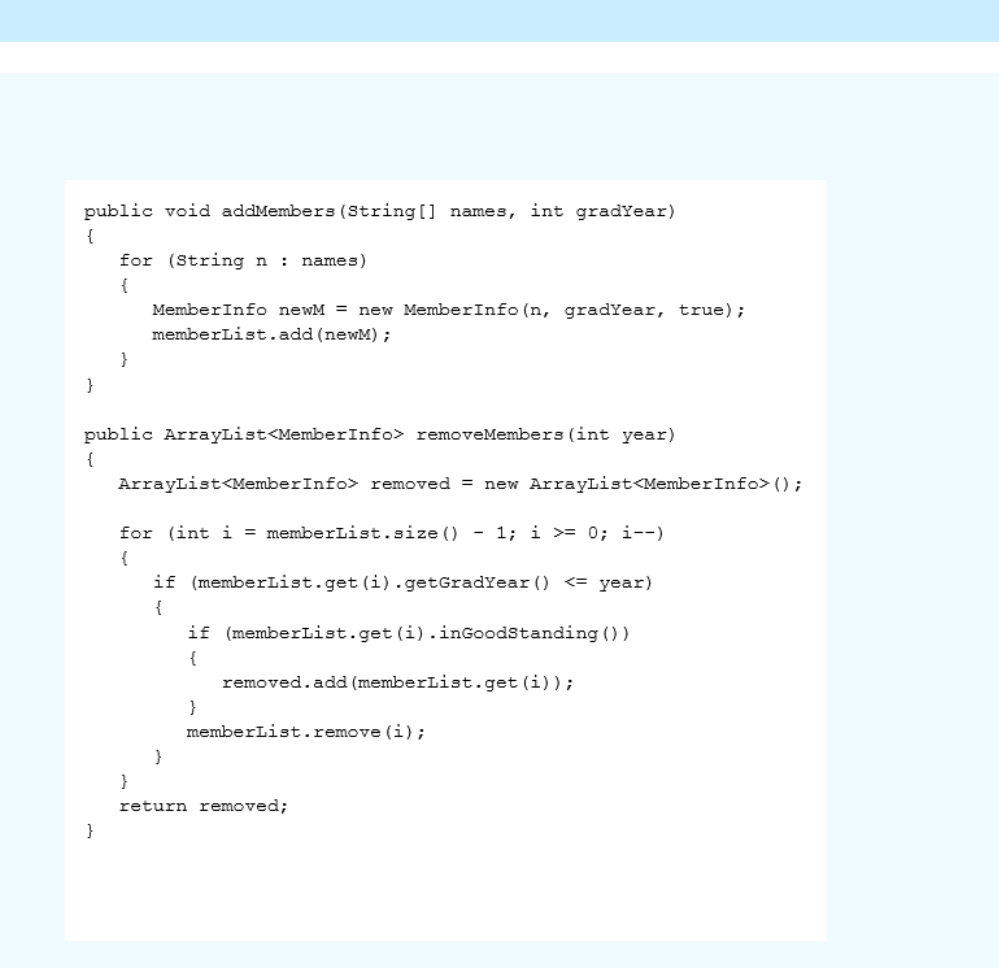
AP® Computer Science A 2021 Scoring Guidelines
© 2021 College Board
Question 3: Array / ArrayList 9 points
Canonical solution
(a)
3 points
(b)
6 points

AP® Computer Science A 2021 Scoring Guidelines
© 2021 College Board
(a)
addMembers
Scoring Criteria Decision Rules
1 Accesses all elements of names (no
bounds errors)
Responses will not earn the point if they
fail to access elements of the array, even if
loop bounds are correct
1 point
2
Instantiates a MemberInfo object with
n
ame from array, provided year, and good
standing
1 point
3 Adds MemberInfo objects to
memberList (in the context of a loop)
Responses can earn the point even if they
instantiate MemberInfo objects
incorrectly
1 point
Total for part (a) 3 points

AP® Computer Science A 2021 Scoring Guidelines
© 2021 College Board
(b)
removeMembers
Scoring Criteria Decision Rules
4 Declares and initializes an ArrayList of
MemberInfo objects
Responses will not earn the point if they
initialize the variable with a reference to
the instance variable
1 point
5 Accesses all elements of memberList for
potential removal (no bounds errors)
Responses will not earn the point if they
• fail to use get(i)
• fail to attempt to remove an element
• skip an element
• throw an exception due
to removing
1 point
6 Calls getGradYear or
inGoodStanding
Responses can still earn the point even if
they call only one of the methods
Responses will not earn the point if they
• ever include parameters in either
met
hod call
• ever call either me
thod on an object
other than MemberInfo
1 point
7 Distinguishes any three cases, based on
graduation status and standing
Responses will not earn the point if they
fail to behave differently in all three cases
1 point
8 Identifies graduating members Responses can still earn the point even if
they
• fail to distinguish three cases
• fail to access standing at all
• access the graduating year incorrectly
Res
ponses will n
ot earn the point if they
confuse < and <= in the comparison
1 point
9 Removes appropriate members from
memberList and adds appropriate
members to the ArrayList to be
returned
Responses can still earn the point even if
they
• call getGradYear or
inGoodStanding inco
rrectly
• access elements of memberList
incorre
ctly
• initialize the ArrayList incorrectly
• fail to return the list that was built
(retu
rn is not assessed)
Responses will n
ot earn the point if they
• fail to declare an ArrayList to
return
• fail to
distinguish the correct three
cases,
with the exception of confusing
the < and <= in the comparison
1 point
Total for part (b) 6 points

AP® Computer Science A 2021 Scoring Guidelines
© 2021 College Board
Question-specific penalties
None
Total for question 3 9 points
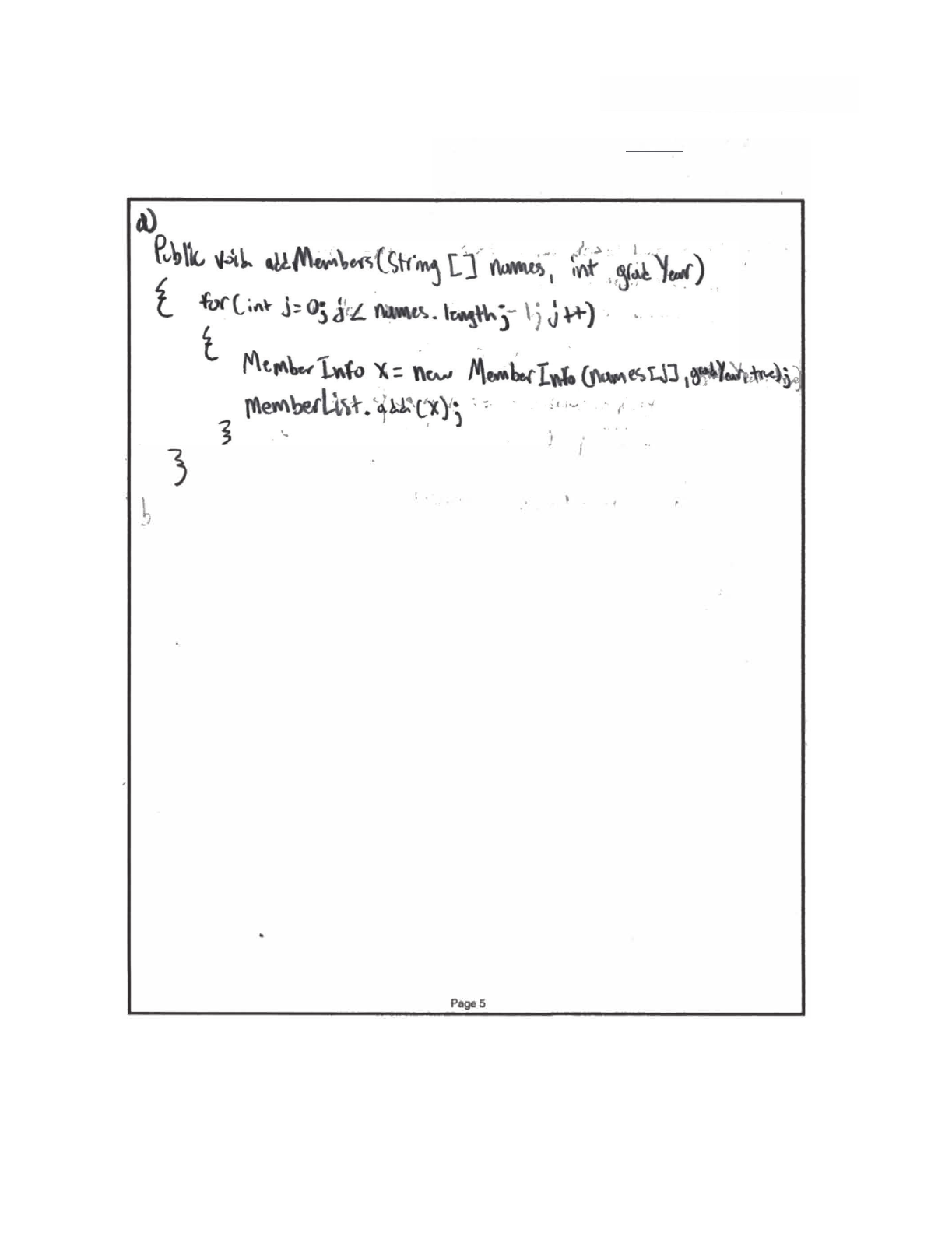
Q3 Sample A
1 of 2
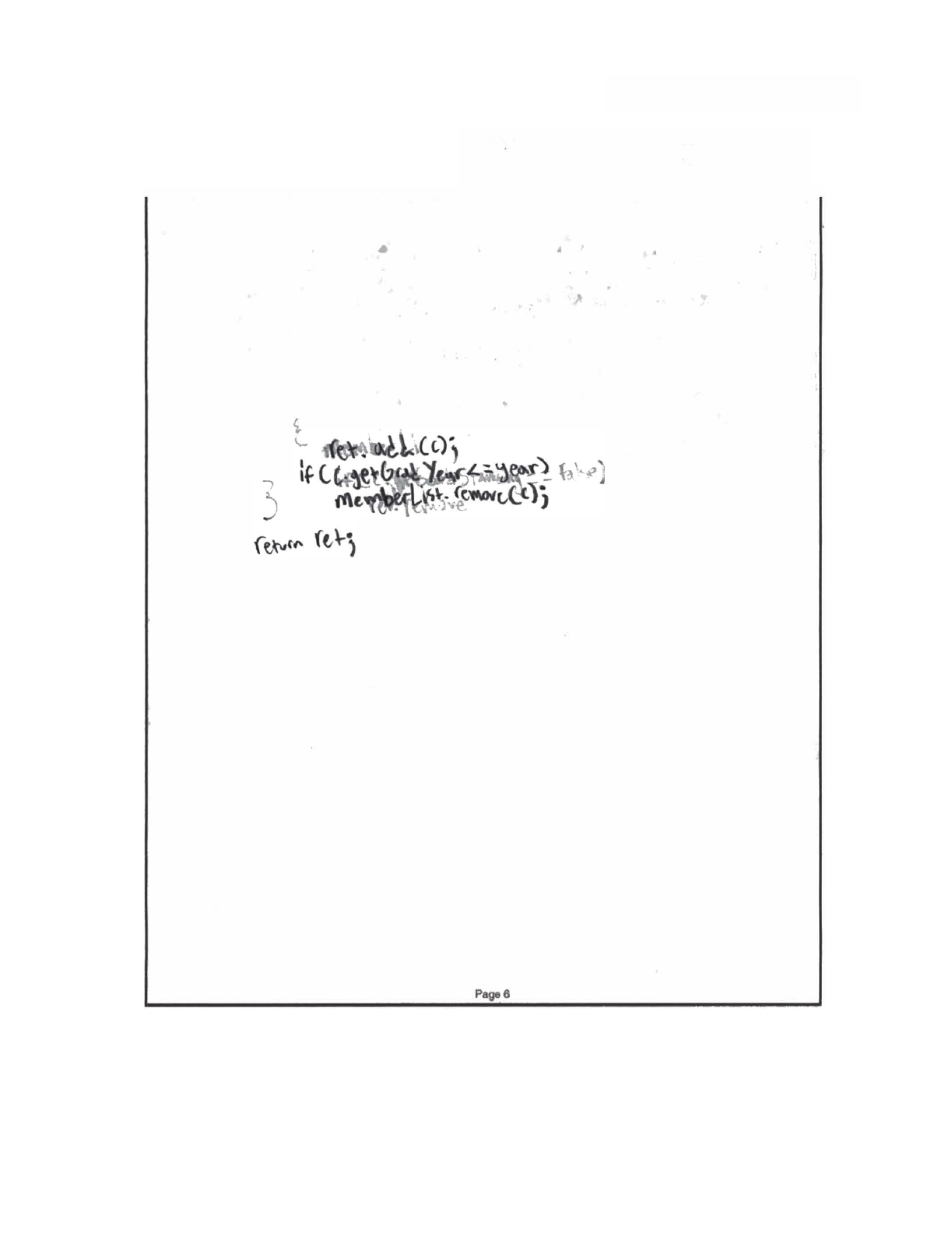
•
Q3 Sample A 2 of 2
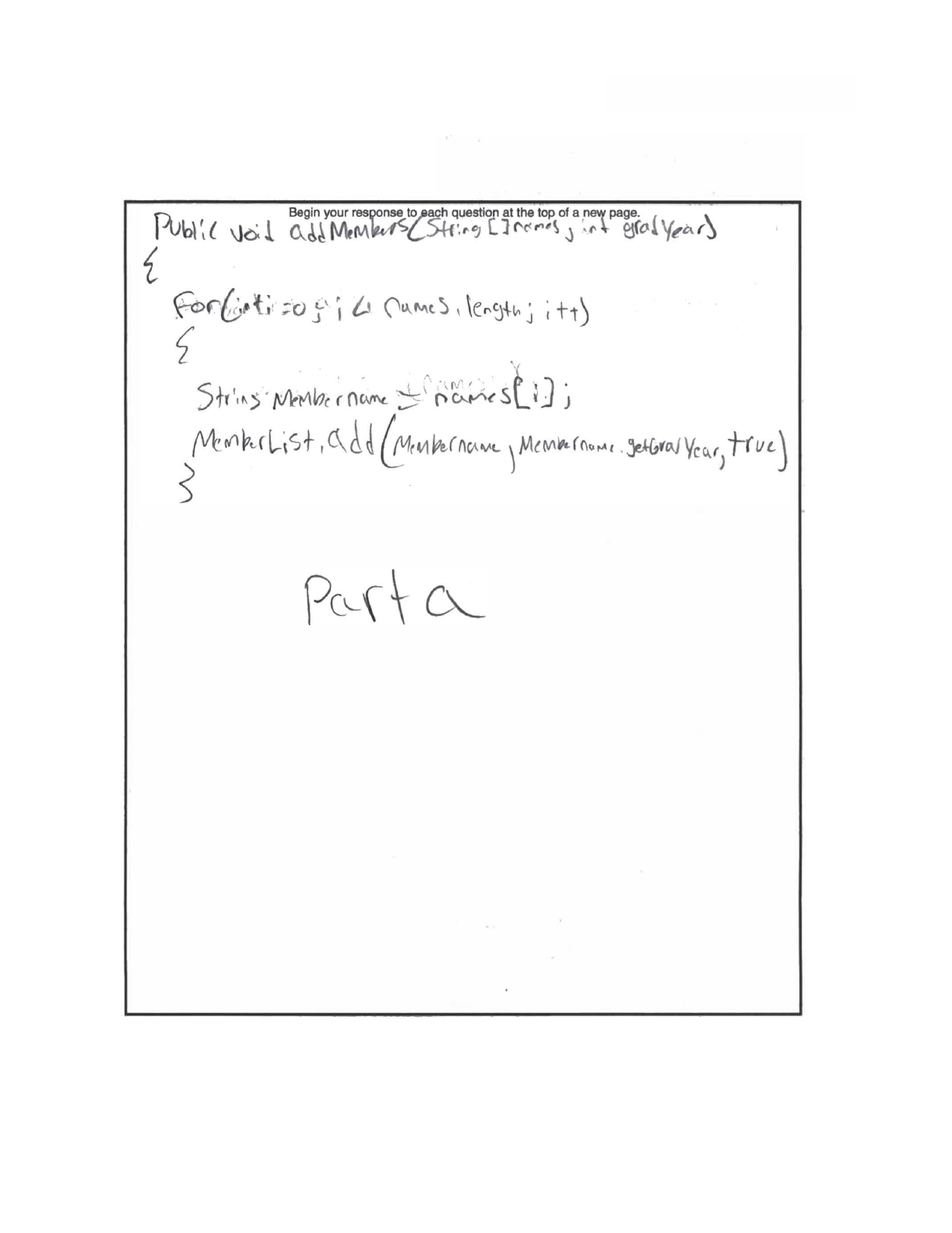
Q3 Sample B
•
1 of 2
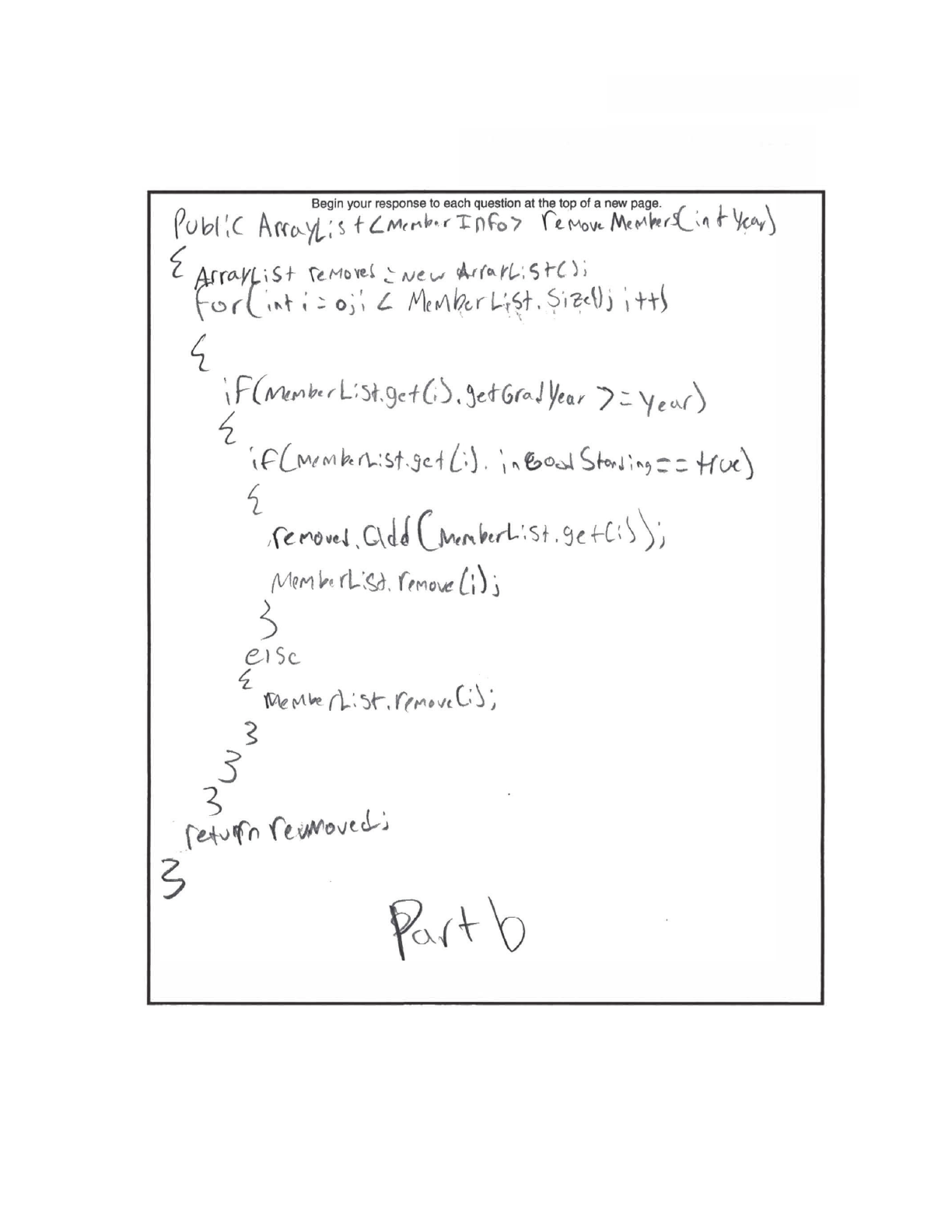
Q3 Sample B 2 of 2
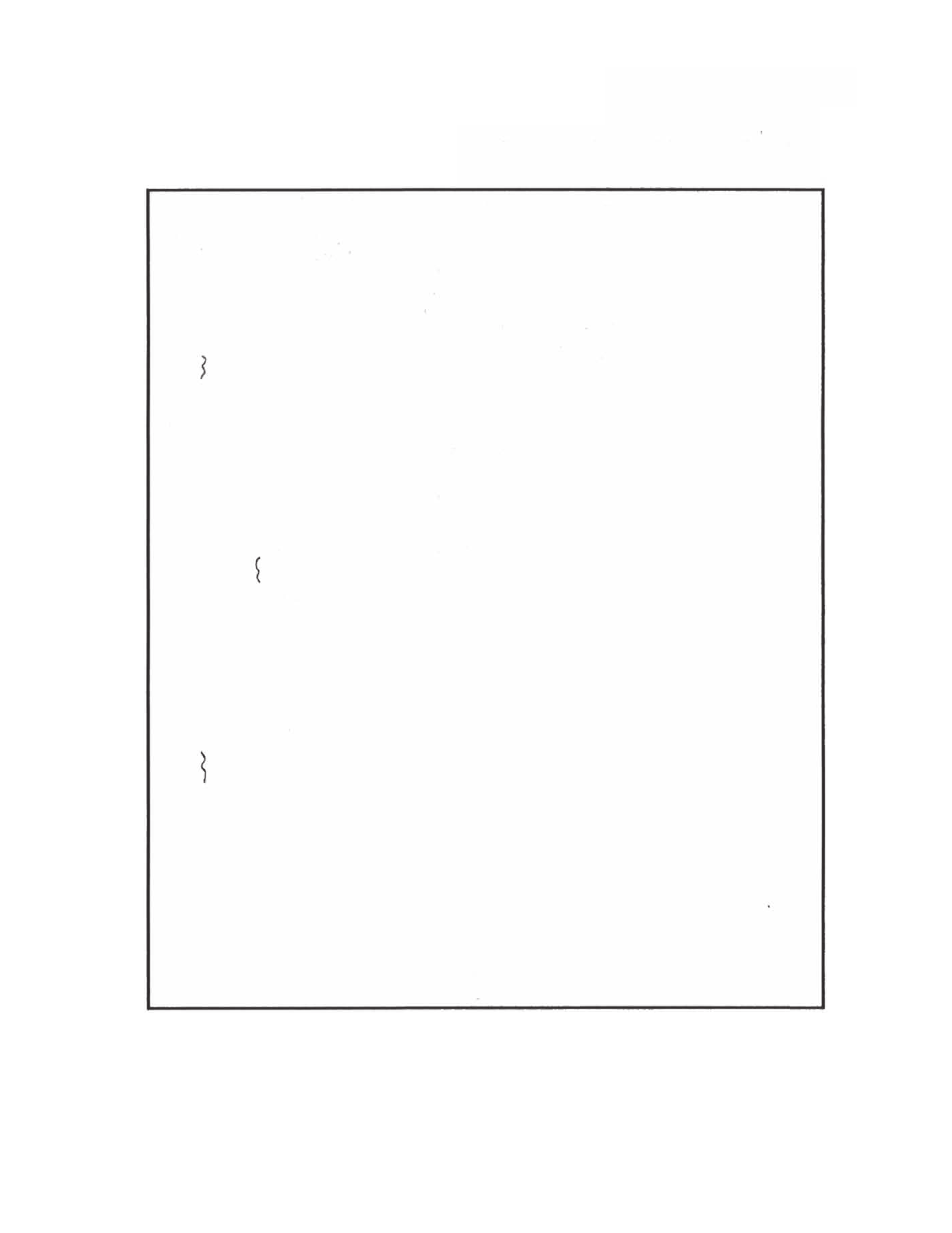
Q3 Sample C
1 of 1

AP
®
Computer Science A 2021 Scoring Commentary
© 2021 College Board.
Visit College Board on the web: collegeboard.org.
Question 3
Overview
This question tested the student’s ability to:
• Write program code to create objects of a class and call methods.
• Write program code to satisfy methods using expressions, conditional statements, and iterative
statements.
• Write program code to create, traverse, and manipulate elements in 1D array or ArrayList objects.
This question involved the manipulation of both a one-dimensional array containing String values and an
Arra
yList containing MemberInfo objects. Students were expected to write two methods in the enclosing
ClubMembers class, making use of its ArrayList instance variable as well as two methods from the
MemberInfo class.
In part (a) students were expected to write a loop to access each element of an array parameter. Inside the loop,
students were expected to: (1) Construct a MemberInfo object using the new keyword and three parameters: a
name from the array, gradYear, and true, in that order; (2) Add the constructed MemberInfo object to the
ClubMembers instance variable memberList.
In part (b) students were asked to develop an algorithm to: (1) Identify club members who have graduated and are
in good standing and add those club members to an ArrayList to be returned; (2) Remove from memberList
those club members who have graduated, regardless of whether or not they are in good standing; and (3) Leave
club members who have not yet graduated in memberList. Students had to create an ArrayList of
MemberInfo objects to be returned and write a loop to access each element of the given ArrayList instance
variable. Inside the loop, students had to call getGradYear and correctly compare the int return value to the
year parameter. They also had to call inGoodStanding and use the boolean return value appropriately.
Sample: 3A
Score: 8
In part (a) poi
nt 1 was earned by accessing all elements of names with no bounds errors. The response uses a
traditional for loop with correct lower and upper bounds. Within the context of the loop, the response
accesses names[j]. Point 2 was earned by instantiating a MemberInfo object by using the keyword new
and the correct parameters. Point 3 was earned by adding MemberInfo objects to memberList in the
context of a loop. The response correctly calls the add method for memberList with the parameter of an
instantiated MemberInfo object that has been assigned to a separate variable.
In part (b) point 4 was earned by correctly declaring and initializing an ArrayList of MemberInfo objects.
P
oint 5 was not earned because the response calls the remove method within an enhanced for loop, which
causes an exception to be thrown. Point 6 was earned because there are correct calls to both the
getGradYear and inGoodStanding methods. Omitting the () on each method call falls into the "No
Penalty" category. Point 7 was earned because the response distinguishes three cases, based on graduation
status and standing. The three identified cases are: (1) members who have graduated in good standing;
(2) members who have graduated but are not in good standing; and (3) members who have not yet graduated.
Point 8 was earned by identifying graduating members. The response correctly identifies graduating members
by checking if the graduation year returned by the method call is less than or equal to the method’s year
parameter. Point 9 was earned because the response first correctly identifies graduating members in good
standing and adds them to the ArrayList to be returned, then identifies graduating members and removes
them from memberList. Members who have not yet graduated remain in memberList. Note that the
AP
®
Computer Science A 2021 Scoring Commentary
© 2021 College Board.
Visit College Board on the web: collegeboard.org.
Question 3 (continued)
faint } at the end of the loop may have been erased, but because the indentation of the response clearly
conveys intent, the possibly missing } is one of the minor errors for which no penalty is assessed. (See the
"No Penalty" category on page 1 of the Scoring Guidelines for a complete list.)
Sample: 3B
Score: 5
In part (a) point 1 was earned by accessing names[i] in a traditional for loop with correct bounds. Point 2
was not earned because the response makes no attempt to instantiate a MemberInfo object using the
keyword new and the correct parameters. Point 3 was not earned because the response does not add a
MemberInfo object to memberList within a loop.
In part (b) point 4 was earned because the ArrayList is declared and initialized correctly. The response
do
es not declare an object type for the ArrayList but it is not always required in a statement of this form;
current versions of Java permit the angle-bracketed types to be omitted in certain circumstances when the type
can be inferred. When writing a method that returns an ArrayList<MemberInfo>, all of the following
ArrayList declarations and instantiations will work and receive credit:
ArrayList<MemberInfo> list1 = new ArrayList<MemberInfo>();
ArrayList<MemberInfo> list2 = new ArrayList();
ArrayList list3 = new ArrayList<MemberInfo>();
ArrayList list4 = new ArrayList();
ArrayList<MemberInfo> list5 = new ArrayList<>();
ArrayList list6 = new ArrayList<>();
ArrayList ArrayList = new ArrayList();
Point 5 was not earn
ed because the response does a forward traversal of the ArrayList with a call to the
remove method and does not account for the shift left of elements. Point 6 was earned because the calls to the
getGradYear and inGoodStanding methods are correct. Point 7 was earned because the response
distinguishes three cases based on graduation status and standing. The response behaves differently in all
three cases. Point 8 was not earned because the response incorrectly determines if the graduation year is
greater than or equal to year. Point 9 was earned because, following the use of an incorrect operator, a
subset of the graduates is removed from memberList and some of the removed members are added
appropriately to the ArrayList to be returned, based on standing.
Sample: 3C
Score: 4
In part (a) point 1 was earned by accessing names[i] in a traditional for loop with correct bounds. Point 2
wa
s earned by instantiating a MemberInfo object using the keyword new and the correct parameters.
Point 3 was earned by adding MemberInfo objects to memberList within a loop.
In part (b) point 4 was not earned because even though the ArrayList is declared correctly, it is not
ini
tialized as an ArrayList of MemberInfo objects. Point 9 can still be earned because only a declaration
is required for that point. Point 5 was not earned because the response does a forward traversal of the
ArrayList with a call to the remove method and does not account for the shift left of elements. Point 6 was
earned because there is a correct call to either the getGradYear or inGoodStanding methods. In this
case, a call to getGradYear correctly occurs on a MemberInfo object. Point 7 was not earned because the
response fails to access standing and because the response only distinguishes two cases. Point 8 was not
AP
®
Computer Science A 2021 Scoring Commentary
Question 3 (continued)
earned because the response incorrectly identifies graduating members by checking if the graduation year ==
year. Point 9 was not earned because the response does not distinguish the correct three cases based on
graduation status and standing.
© 2021 College Board.
Visit College Board on the web: collegeboard.org.
